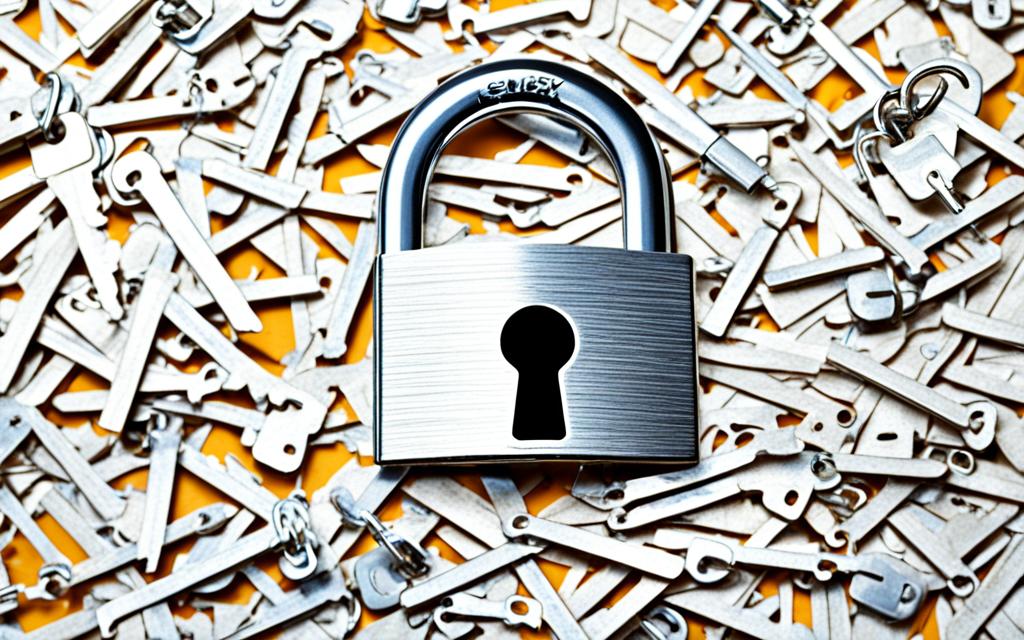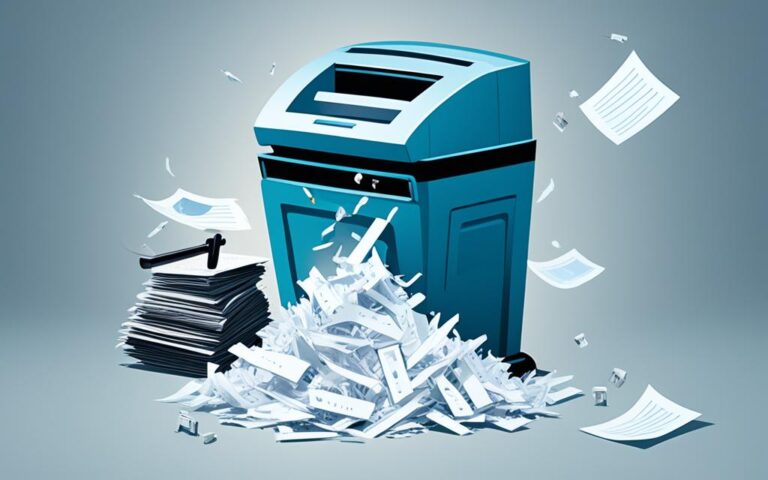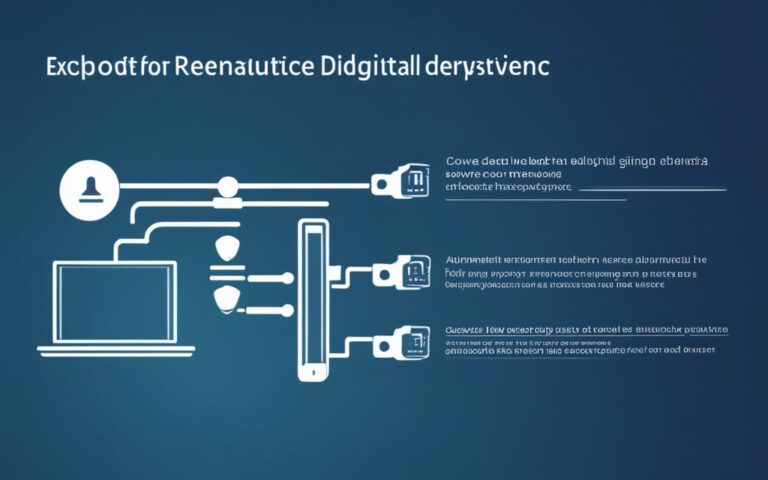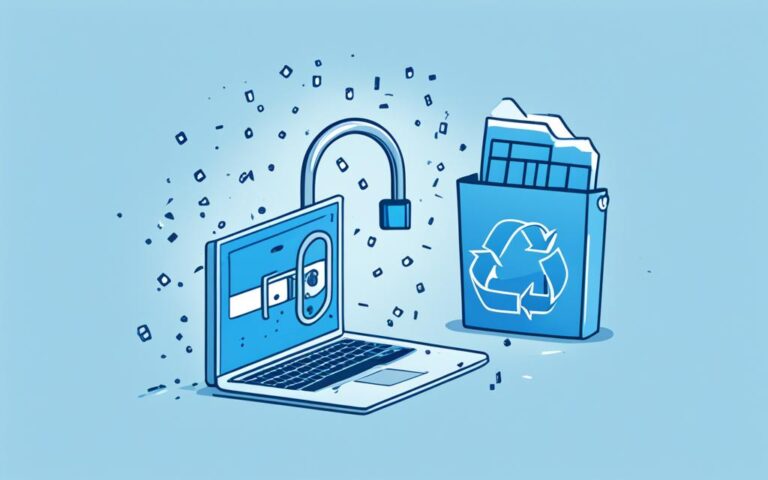Best Practices in Secure Data Sanitization
Protecting sensitive information and ensuring compliance with data privacy regulations are paramount concerns for businesses and individuals alike. Secure data sanitisation plays a pivotal role in achieving these objectives. In this section, we will explore the best practices that can help safeguard your data and mitigate the risk of unauthorized access.
Secure data sanitisation involves the permanent removal of data from various storage media, ensuring that it cannot be recovered. Implementing effective practices in this area is crucial for maintaining the confidentiality and integrity of sensitive information.
By adhering to best practices, you can ensure that your data sanitisation efforts are robust and reliable. This not only protects your organization from potential data breaches but also helps you meet legal and regulatory requirements.
Throughout this section, we will explore each step of the data sanitisation process in detail, providing you with actionable insights and strategies to protect your sensitive information. From developing a comprehensive data destruction policy to categorising and organising data, choosing appropriate data destruction methods, securing shredding services for physical data, and training employees on secure data handling, we will cover all aspects of secure data sanitisation.
It is crucial to adopt these best practices to not only safeguard your data but also demonstrate your commitment to compliance and data privacy. By following these guidelines, you can protect your sensitive information from falling into the wrong hands and avoid the potential consequences of data breaches.
Stay tuned for the upcoming sections, where we will dig deeper into the importance of secure data sanitisation and explore various strategies to ensure the comprehensive protection of your data.
Understanding the Importance of Secure Data Sanitisation
Secure data sanitisation is crucial for both businesses and individuals to protect sensitive information and prevent unauthorized access. It involves the permanent removal of data from media to ensure it cannot be recovered. By implementing secure data sanitisation practices, organisations can mitigate the risk of data breaches and comply with privacy regulations.
With the rise in cyber threats and the increasing value of data, secure data sanitisation has become a top priority for organisations across industries. Whether it’s financial data, customer records, or proprietary information, protecting sensitive information is essential to maintain trust, reputation, and legal compliance.
One of the main reasons secure data sanitisation is necessary is to prevent unauthorized access to confidential data. When devices or storage media are discarded without proper sanitisation, sensitive information can fall into the wrong hands, leading to potential data breaches and identity theft.
The consequences of data breaches can be severe, resulting in financial losses, legal liabilities, and damage to an organisation’s reputation. By securely sanitising data before disposal, organisations can significantly reduce the risk of such incidents and safeguard their sensitive information.
To illustrate the importance of secure data sanitisation, consider the following scenario:
Imagine a company disposes of an old server without securely sanitising the data it contains. The server ends up in the possession of a malicious individual who manages to extract valuable customer information, including names, addresses, and credit card details. This data breach exposes thousands of customers to identity theft and financial fraud. As a result, the company faces hefty fines, lawsuits, and a significant loss of customer trust.
Implementing secure data sanitisation practices is essential for organisations to maintain compliance with privacy regulations. Data protection laws, such as the General Data Protection Regulation (GDPR), require businesses to protect personal data and ensure its secure disposal. Failure to comply with these regulations can lead to severe penalties and sanctions.
By securely sanitising data before disposal, businesses can demonstrate their commitment to protecting sensitive information and complying with privacy regulations. This not only helps to mitigate the risk of data breaches but also fosters customer trust and loyalty.
To summarise, secure data sanitisation is essential for businesses and individuals alike. By permanently removing data from media, organisations can protect sensitive information, prevent unauthorized access, and comply with privacy regulations. Implementing secure data sanitisation practices is a proactive approach to safeguarding data, mitigating the risk of data breaches, and maintaining trust with customers.
Developing a Comprehensive Data Destruction Policy
The first step in implementing secure data sanitisation is to develop a comprehensive data destruction policy. This policy should outline the entire data lifecycle within the organisation and clearly define which types of data require secure destruction. By establishing protocols for the disposal of various storage media, organisations can ensure the secure destruction of sensitive information.
A well-designed data destruction policy provides a framework for managing the entire data destruction process. It enables organisations to systematically identify, assess, and address the risks associated with sensitive information. With a clear policy in place, employees can better understand their responsibilities and the procedures for handling and disposing of data.
When developing a data destruction policy, it is important to consider the following:
-
Legal and regulatory requirements: Ensure that the policy aligns with applicable laws and regulations governing data protection and privacy. This includes understanding retention periods and requirements for specific types of data.
-
Data classification: Classify data based on its sensitivity and confidentiality. This allows for targeted and appropriate destruction methods based on the level of security required.
-
Storage media: Clearly define which storage media devices and formats are covered by the policy, such as hard drives, solid-state drives, tapes, USB drives, and optical discs.
-
Destruction methods: Outline the approved methods for data destruction, including physical destruction (such as shredding or degaussing) and digital destruction (such as data wiping or encryption).
-
Responsibilities and procedures: Identify the roles and responsibilities of individuals involved in the data destruction process, such as IT personnel, compliance officers, and data custodians. Establish clear procedures for data disposal, including who is authorized to initiate destruction and how records are maintained.
-
Monitoring and auditing: Implement mechanisms to monitor compliance with the policy and conduct regular audits to ensure adherence to standards. This includes reviewing destruction logs, maintaining records of destruction, and verifying the effectiveness of the process.
-
Employee training: Provide comprehensive training to ensure that employees are aware of the data destruction policy, understand their responsibilities, and are proficient in the proper methods of secure destruction.
Developing a comprehensive data destruction policy is an essential step in safeguarding sensitive information and ensuring compliance with data protection laws. By defining clear procedures and responsibilities, organisations can effectively manage the secure destruction of data and mitigate the risk of unauthorized access or data breaches.
Categorising and Organising Data
To effectively sanitise data, it is important to categorise and organise it based on sensitivity and confidentiality levels. By classifying data and following retention laws, organisations can ensure that their data destruction efforts are targeted and compliant.
When categorising data, it is crucial to consider its sensitivity and the potential risks associated with its exposure. This allows organisations to prioritise the security measures required for each type of data. By identifying the most sensitive data, organisations can allocate appropriate resources and implement robust security controls to safeguard against potential breaches.
Organising data is equally important, as it enables efficient data management and retrieval. Organisations should establish clear data storage systems and naming conventions to facilitate easy access and tracking. By implementing a logical and structured organisation system, organisations can streamline their data sanitisation processes and ensure that all data is appropriately managed.
“Properly categorising and organising data is the foundation of effective data sanitisation. By prioritising security measures and implementing clear organisational structures, organisations can protect sensitive information and comply with data protection regulations.” – [Expert Name], Data Security Consultant
A comprehensive data categorisation and organisation strategy should consider the following steps:
- Identify data categories based on sensitivity and confidentiality.
- Assign appropriate security controls and access rights to different data categories.
- Implement a consistent naming convention for files and documents.
- Establish a centralised data repository for easy management and retrieval.
- Regularly review and update the categorisation and organisation strategies to adapt to changing data needs.
Benefits of Categorising and Organising Data
Categorising and organising data offers several key benefits:
- Enhanced data security: By categorising and prioritising sensitive data, organisations can allocate appropriate resources and security measures to protect it from unauthorised access.
- Efficient data management: Organising data allows for easy access and retrieval, improving overall data management processes.
- Compliance with data protection regulations: Following best practices in data categorisation and organisation ensures organisations remain compliant with data protection laws and retention requirements.
To illustrate the impact of categorising and organising data, consider the following example:
| Data Category | Security Measures |
|---|---|
| Confidential financial records | Restricted access, encryption, regular audits |
| Employee performance evaluations | Access controls, limited retention period |
| Customer contact information | Data encryption, secure storage, consent management |
In this example, the organisation has effectively categorised and organised their data based on sensitivity. By implementing tailored security measures for each data category, they can ensure that sensitive information is adequately protected.
By categorising and organising data, organisations can effectively prioritise security measures, streamline data management processes, and ensure compliance with data protection regulations. Implementing a comprehensive categorisation and organisation strategy is a crucial step in the secure data sanitisation process.
Choosing Appropriate Data Destruction Methods
Different types of data require different destruction methods. When it comes to physical media such as hard drives and tapes, shredding or degaussing is highly effective in ensuring secure data destruction. For digital data stored on devices, using data-wiping software with industry-standard algorithms provides comprehensive erasure. It is crucial to select the appropriate method based on the specific type of data and media involved.
For physical media, shredding involves physically breaking down the storage devices into small pieces, rendering the data irretrievable. Alternatively, degaussing utilizes powerful magnets to disrupt the magnetic storage medium, erasing all data.
When it comes to digital data, data-wiping software overwrites the existing data multiple times with random patterns, making it nearly impossible to recover. These software applications adhere to industry-standard algorithms, ensuring thorough erasure of sensitive information.
In selecting the appropriate data destruction method, it is essential to consider factors such as the sensitivity of the data, the level of confidentiality required, and the type of storage media used.
Using the right method for data destruction is crucial to protect against unauthorized access and ensure compliance with data privacy regulations.
Here is a table comparing the key attributes of shredding, degaussing, and data-wiping:
| Method | Effectiveness | Applicable Media | Key Benefits |
|---|---|---|---|
| Shredding | Highly effective | Hard drives, tapes | Physical destruction of media, irreversible data loss |
| Degaussing | Highly effective | Hard drives, tapes | Disrupts magnetic storage, rendering data unrecoverable |
| Data-Wiping | Highly effective | Digital storage devices | Multiple overwrites of data, thorough erasure |
By carefully evaluating the specific requirements and considering the type of data and media involved, businesses and individuals can make informed decisions when choosing the appropriate data destruction method to ensure the secure and permanent elimination of sensitive information.
Securing Shredding Services for Physical Data
When it comes to the secure destruction of paper documents, partnering with a trusted shredding service provider is essential. These services ensure that your confidential information remains protected throughout the disposal process. There are various secure shredding options available, including mobile shredding, off-site shredding, and ship N shred.
Mobile shredding services offer convenience by bringing the shredding directly to your location. A specialized shredding truck equipped with high-capacity shredding equipment will securely destroy your paper documents on-site. This allows you to witness the shredding process, ensuring complete peace of mind.
Off-site shredding services, on the other hand, involve the collection of your paper documents by the shredding service provider. The documents are then securely transported to a shredding facility for destruction. This option is suitable for larger volumes of paper documents and offers a secure and efficient solution for disposal.
Ship N shred services provide a convenient way to securely destroy your paper documents. The service provider supplies you with a specially designed shred box. You fill the box with your paper documents, and once it’s full, you ship it back to the provider using a pre-paid shipping label. The documents are then shredded and securely destroyed at the provider’s facility.
These shredding services adhere to industry standards, ensuring the secure destruction of your paper documents. They utilize advanced shredding equipment that renders the documents irrecoverable. Additionally, these services provide certificates of destruction, confirming that your confidential information has been disposed of properly.
Partnering with a secure shredding service provider is crucial to protect the confidentiality of your paper documents and ensure compliance with data protection regulations.
Figure 6: Secure shredding services offer a reliable and convenient way to dispose of paper documents securely.
Employee Training and Awareness
The effectiveness of data destruction practices relies heavily on the awareness and diligence of employees. Comprehensive training on data destruction policies, methods, and the importance of secure practices is crucial in ensuring the protection of sensitive information and preventing data breaches. By equipping employees with the necessary knowledge and skills, organizations can establish a culture of data security and minimize the risk of data compromise.
A well-designed employee training program should cover a range of topics, including:
- The importance of secure data handling and the potential consequences of mishandling sensitive information.
- The organization’s data destruction policies, procedures, and guidelines.
- Proper techniques for securely disposing of physical and digital data.
- Identifying and handling different types of data, distinguishing between confidential and non-confidential information.
- Recognizing potential vulnerabilities and threats to data security.
Furthermore, regular awareness campaigns can serve as valuable reminders and reinforce the significance of secure data handling and destruction. These campaigns can take various forms, such as informative emails, posters, or interactive training sessions. By consistently communicating the importance of data security, organizations can foster a culture that prioritizes the protection and responsible handling of sensitive information.
“Employee training and awareness are crucial components of effective data destruction practices. By providing comprehensive training and conducting regular awareness campaigns, organizations can empower their employees to play an active role in data security and protect sensitive information.”
An example of an effective awareness campaign is the annual Data Security Awareness Week, where employees participate in engaging activities, such as quizzes and workshops, to reinforce their knowledge of data destruction policies and best practices. These initiatives not only educate employees but also serve as an opportunity to address any questions or concerns they may have regarding data security.
By prioritizing employee training and awareness, organizations can establish a strong foundation for secure data handling and promote a culture of data security throughout the entire workforce.
Benefits of Employee Training and Awareness:
- Minimizes the risk of data breaches caused by human error or negligence.
- Ensures compliance with data protection regulations and industry standards.
- Creates a culture of data security and accountability within the organization.
- Empowers employees with the knowledge and skills to confidently handle sensitive information.
- Promotes a proactive approach to data security, reducing the likelihood of security incidents.
| Employee Training and Awareness | Benefits |
|---|---|
| Comprehensive training on data destruction policies, methods, and secure practices. | Fosters a culture of data security and accountability. |
| Regular awareness campaigns to reinforce the significance of secure data handling. | Minimizes the risk of data breaches caused by human error. |
| Interactive activities and workshops for employee engagement. | Ensures compliance with data protection regulations. |
Conclusion
Secure data sanitisation is an essential practice for businesses to protect sensitive information and ensure compliance. By adopting best practices in data destruction, organisations can mitigate the risk of data breaches and safeguard their valuable data.
Developing a comprehensive data destruction policy is the first step towards secure data sanitisation. By clearly defining which types of data require secure destruction and establishing protocols for disposal, organisations can ensure the proper handling of sensitive information.
Choosing appropriate data destruction methods is also crucial. Whether it’s physical media like hard drives or digital data on storage devices, selecting the right method ensures thorough erasure. Shredding services for physical data, provided by reputable providers like IT-Recycle, offer secure destruction and provide certificates of destruction.
Employee training and awareness play a significant role in implementing effective data sanitisation practices. By educating employees about data destruction policies and the importance of secure handling, organisations can foster a culture of data security and prevent data breaches.
Regular audits should also be conducted to evaluate and improve data sanitisation practices. By reviewing policies, procedures, and compliance with regulations, organisations can identify areas for improvement and ensure ongoing data security.
Protecting sensitive information is paramount in today’s digital age. By following best practices in secure data sanitisation, businesses can protect their data, maintain compliance, and build trust with their customers and stakeholders.
For more information on secure data sanitisation and server recycling, visit IT-Recycle.
FAQ
What is secure data sanitisation?
Secure data sanitisation involves the permanent removal of data from media to ensure it cannot be recovered. It is essential for protecting sensitive information and preventing unauthorized access.
Why is secure data sanitisation important?
Secure data sanitisation is important to protect sensitive information and comply with privacy regulations. It helps mitigate the risk of data breaches and ensures the confidentiality of personal and business data.
How can I develop a comprehensive data destruction policy?
Developing a comprehensive data destruction policy involves outlining the entire data lifecycle within your organization and defining which types of data require secure destruction. It establishes protocols for the disposal of various storage media to ensure the secure destruction of sensitive information.
Why is categorizing and organizing data important for secure data sanitisation?
Categorizing and organizing data based on sensitivity and confidentiality levels allows organizations to prioritize the security measures required for each type of data. It ensures that data destruction efforts are targeted and compliant with retention laws.
What are the appropriate data destruction methods?
The appropriate data destruction methods depend on the type of data and media. For physical media like hard drives and tapes, shredding or degaussing is effective. For digital data on storage devices, data-wiping software with industry-standard algorithms ensures thorough erasure.
How can I secure shredding services for physical data?
You can secure shredding services for physical data by partnering with a secure shredding service provider. Mobile shredding, off-site shredding, and ship N shred are all secure options. These services adhere to industry standards and provide certificates of destruction to ensure the confidentiality of the disposed documents.
Why is employee training and awareness important for secure data sanitisation?
Employee training and awareness are important for secure data sanitisation as they ensure that employees understand data destruction policies, methods, and the importance of secure practices. Regular awareness campaigns reinforce the significance of secure data handling and destruction to prevent data breaches.













